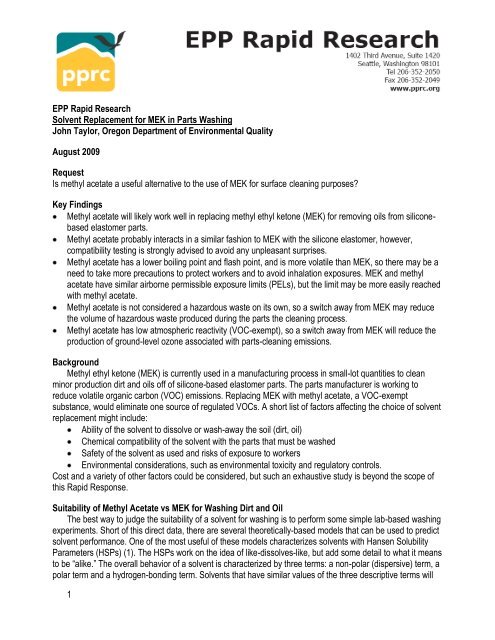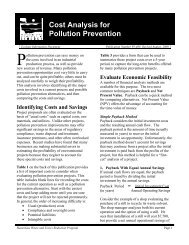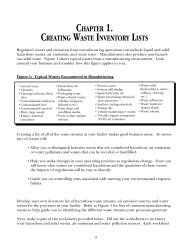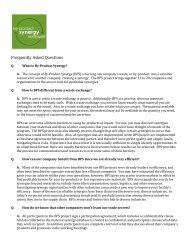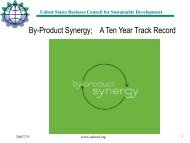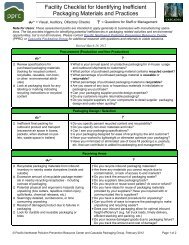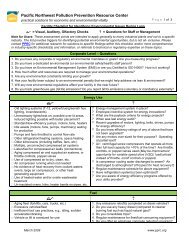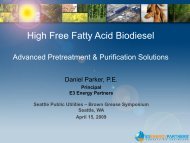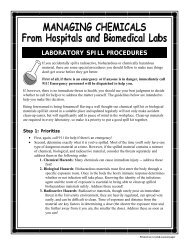Solvent Replacement for MEK in Parts Washing
Solvent Replacement for MEK in Parts Washing
Solvent Replacement for MEK in Parts Washing
Create successful ePaper yourself
Turn your PDF publications into a flip-book with our unique Google optimized e-Paper software.
EPP Rapid Research<br />
<strong>Solvent</strong> <strong>Replacement</strong> <strong>for</strong> <strong>MEK</strong> <strong>in</strong> <strong>Parts</strong> Wash<strong>in</strong>g<br />
John Taylor, Oregon Department of Environmental Quality<br />
August 2009<br />
Request<br />
Is methyl acetate a useful alternative to the use of <strong>MEK</strong> <strong>for</strong> surface clean<strong>in</strong>g purposes<br />
Key F<strong>in</strong>d<strong>in</strong>gs<br />
Methyl acetate will likely work well <strong>in</strong> replac<strong>in</strong>g methyl ethyl ketone (<strong>MEK</strong>) <strong>for</strong> remov<strong>in</strong>g oils from siliconebased<br />
elastomer parts.<br />
Methyl acetate probably <strong>in</strong>teracts <strong>in</strong> a similar fashion to <strong>MEK</strong> with the silicone elastomer, however,<br />
compatibility test<strong>in</strong>g is strongly advised to avoid any unpleasant surprises.<br />
Methyl acetate has a lower boil<strong>in</strong>g po<strong>in</strong>t and flash po<strong>in</strong>t, and is more volatile than <strong>MEK</strong>, so there may be a<br />
need to take more precautions to protect workers and to avoid <strong>in</strong>halation exposures. <strong>MEK</strong> and methyl<br />
acetate have similar airborne permissible exposure limits (PELs), but the limit may be more easily reached<br />
with methyl acetate.<br />
Methyl acetate is not considered a hazardous waste on its own, so a switch away from <strong>MEK</strong> may reduce<br />
the volume of hazardous waste produced dur<strong>in</strong>g the parts the clean<strong>in</strong>g process.<br />
Methyl acetate has low atmospheric reactivity (VOC-exempt), so a switch away from <strong>MEK</strong> will reduce the<br />
production of ground-level ozone associated with parts-clean<strong>in</strong>g emissions.<br />
Background<br />
Methyl ethyl ketone (<strong>MEK</strong>) is currently used <strong>in</strong> a manufactur<strong>in</strong>g process <strong>in</strong> small-lot quantities to clean<br />
m<strong>in</strong>or production dirt and oils off of silicone-based elastomer parts. The parts manufacturer is work<strong>in</strong>g to<br />
reduce volatile organic carbon (VOC) emissions. Replac<strong>in</strong>g <strong>MEK</strong> with methyl acetate, a VOC-exempt<br />
substance, would elim<strong>in</strong>ate one source of regulated VOCs. A short list of factors affect<strong>in</strong>g the choice of solvent<br />
replacement might <strong>in</strong>clude:<br />
Ability of the solvent to dissolve or wash-away the soil (dirt, oil)<br />
Chemical compatibility of the solvent with the parts that must be washed<br />
Safety of the solvent as used and risks of exposure to workers<br />
Environmental considerations, such as environmental toxicity and regulatory controls.<br />
Cost and a variety of other factors could be considered, but such an exhaustive study is beyond the scope of<br />
this Rapid Response.<br />
Suitability of Methyl Acetate vs <strong>MEK</strong> <strong>for</strong> Wash<strong>in</strong>g Dirt and Oil<br />
The best way to judge the suitability of a solvent <strong>for</strong> wash<strong>in</strong>g is to per<strong>for</strong>m some simple lab-based wash<strong>in</strong>g<br />
experiments. Short of this direct data, there are several theoretically-based models that can be used to predict<br />
solvent per<strong>for</strong>mance. One of the most useful of these models characterizes solvents with Hansen Solubility<br />
Parameters (HSPs) (1). The HSPs work on the idea of like-dissolves-like, but add some detail to what it means<br />
to be “alike.” The overall behavior of a solvent is characterized by three terms: a non-polar (dispersive) term, a<br />
polar term and a hydrogen-bond<strong>in</strong>g term. <strong>Solvent</strong>s that have similar values of the three descriptive terms will<br />
1
likely behave similarly <strong>in</strong> practice. S<strong>in</strong>ce the oily soils or contam<strong>in</strong>ants are likely to be non-polar, it’s probably<br />
more important <strong>for</strong> the <strong>MEK</strong> and any potential replacement to have similar values of the non-polar HSP term.<br />
Table 1 gives the HSP values <strong>for</strong> <strong>MEK</strong>, methyl acetate and some selected solvents. The first three<br />
solvents have similar HSPs, especially <strong>for</strong> the important non-polar term, and may be expected to per<strong>for</strong>m<br />
similarly <strong>for</strong> clean<strong>in</strong>g common oils. Roughly speak<strong>in</strong>g, isopropanol, with its stronger H-bond<strong>in</strong>g component,<br />
would not dissolve oils as well, due to an <strong>in</strong>creased tendency to hydrogen-bond with itself. In other words,<br />
isopropanol’s <strong>in</strong>teraction with other isopropanol molecules competes with its <strong>in</strong>teraction with the oily soil<br />
materials.<br />
<strong>Solvent</strong><br />
Non-Polar<br />
HSP<br />
Polar<br />
HSP<br />
H-Bond<strong>in</strong>g<br />
HSP<br />
Methyl ethyl ketone 7.6 4.4 2.5<br />
Methyl acetate 7.8 3.5 3.7<br />
Methyl n-propyl ketone 7.8 3.7 2.3<br />
Isopropanol 7.7 3.0 8.0<br />
Table 1. Hansen solubility parameters from Eastman Chemical Company (2).<br />
Methyl acetate has a higher vapor pressure and evaporates more quickly than <strong>MEK</strong>. As a result, changes<br />
<strong>in</strong> clean<strong>in</strong>g procedures may be required to account <strong>for</strong> more rapid solvent dry<strong>in</strong>g.<br />
Compatibility of Methyl Acetate with the Part Material<br />
The parts undergo<strong>in</strong>g clean<strong>in</strong>g are a silicone-conta<strong>in</strong><strong>in</strong>g elastomer. HSPs can also be used to understand<br />
how solvents may <strong>in</strong>teract with solid materials. Without additional <strong>in</strong><strong>for</strong>mation on the make-up of the parts, it’s<br />
not possible to determ<strong>in</strong>e whether methyl acetate would swell or otherwise <strong>in</strong>teract with the elastomers used<br />
by the manufacturer. In any case, given the similar HSPs, methyl acetate should <strong>in</strong>teract with the parts <strong>in</strong> a<br />
very similar fashion to <strong>MEK</strong>. This HSP theoretical model is not perfect, so it would be wise to per<strong>for</strong>m some<br />
basic compatibility test<strong>in</strong>g be<strong>for</strong>e chang<strong>in</strong>g solvents <strong>in</strong> the current system.<br />
Safety of <strong>Solvent</strong> <strong>in</strong> Use and Risks of Exposure to Workers<br />
Methyl acetate is more volatile than <strong>MEK</strong>, so it may cause worker exposures or reach dangerous vapor<br />
concentrations more quickly than <strong>MEK</strong>. Like <strong>MEK</strong>, methyl acetate is flammable, but it is more easily ignited<br />
(has a lower flash po<strong>in</strong>t) than <strong>MEK</strong>.<br />
Permissible exposure limits (PELs) are similar <strong>for</strong> <strong>MEK</strong> and methyl acetate, and both solvents are<br />
respiratory irritants, may cause central nervous system depression, and are <strong>in</strong> other ways unhealthy if workers<br />
should become overexposed by dermal contact or vapor <strong>in</strong>halation. All solvent safety data should be reviewed<br />
prior to use <strong>in</strong> any facility, <strong>in</strong>clud<strong>in</strong>g: NIOSH recommendations <strong>for</strong> protective equipment, MSDSs, and human<br />
health impact data (e.g., <strong>in</strong><strong>for</strong>mation at the Hazardous Substances Data Bank). Some l<strong>in</strong>ks to <strong>in</strong><strong>for</strong>mation are<br />
provided <strong>in</strong> the Resource section below.<br />
Environmental Regulation<br />
While on the orig<strong>in</strong>al 1990 list of hazardous air pollutants (HAPs), <strong>MEK</strong> was removed from the list <strong>in</strong> 2005.<br />
<strong>MEK</strong> is still regulated as a VOC. Methyl acetate has a lower chemical reactivity <strong>in</strong> the air environment and is<br />
considered VOC-exempt.<br />
When disposed of, <strong>MEK</strong> must be treated as a hazardous waste and is also a TRI listed chemical. Methyl<br />
acetate is not regulated as a hazardous waste.<br />
Conclusions<br />
Methyl acetate will likely work well to replace <strong>MEK</strong> <strong>in</strong> parts clean<strong>in</strong>g. While theories of solvent behavior are<br />
not flawless, they are a reasonable guide to solvency <strong>in</strong> the absence of specific experimental data. Similarly,<br />
the same solvent theories suggest that methyl acetate will <strong>in</strong>teract with the plastic material of the parts <strong>in</strong> much<br />
the same manner as does <strong>MEK</strong>.<br />
2
Like <strong>MEK</strong>, methyl acetate is flammable and can be hazardous to workers, especially from vapor<br />
exposures. Methyl acetate is substantially more volatile than <strong>MEK</strong>, so it will build up more quickly <strong>in</strong> the air<br />
environment. Given the high volatility, methyl acetate will also dry more quickly and this may require changes<br />
<strong>in</strong> clean<strong>in</strong>g practices.<br />
Methyl acetate is not considered a hazardous waste, so switch<strong>in</strong>g away from <strong>MEK</strong> may permit a reduction<br />
<strong>in</strong> the quantity of hazardous waste generated by clean<strong>in</strong>g operations. Furthermore, given methyl acetate’s low<br />
atmospheric reactivity (VOC-exempt), switch<strong>in</strong>g from <strong>MEK</strong> will also reduce the production of ground-level<br />
ozone associated with emissions from parts clean<strong>in</strong>g.<br />
Items <strong>for</strong> Further Research<br />
There are a variety of proprietary clean<strong>in</strong>g solvents that are offered as environmentally-friendly and may<br />
be worth explor<strong>in</strong>g.<br />
Eastman Chemical Company suggests methyl n-propyl ketone (MPK), both as a pure substance and <strong>in</strong><br />
mixtures with methyl acetate, as a potential replacement <strong>for</strong> <strong>MEK</strong>. The advantage is lower vapor pressure<br />
of MPK when compared with pure methyl acetate. Un<strong>for</strong>tunately, MPK may conta<strong>in</strong> up to 10% methyl<br />
isobutyl ketone, a hazardous air pollutant. MPK is also a regulated VOC, but as it is less volatile than<br />
<strong>MEK</strong>, it would probably lead to reduced VOC emissions <strong>in</strong> a direct replacement <strong>for</strong> <strong>MEK</strong>.<br />
Resources<br />
Eastman Chemical Company provides good <strong>in</strong><strong>for</strong>mation compar<strong>in</strong>g methyl acetate with <strong>MEK</strong> and other<br />
similar solvents <strong>for</strong> clean<strong>in</strong>g applications: http://www.eastman.com/Literature_Center/T/TT24.pdf<br />
Eastman Chemical Company <strong>in</strong><strong>for</strong>mation on <strong>MEK</strong> replacement:<br />
http://www.eastman.com/Literature_Center/T/TT33.pdf<br />
Hazardous Substances Data Bank entry <strong>for</strong> <strong>MEK</strong> (also known as 2-butanone):<br />
http://toxnet.nlm.nih.gov/cgi-b<strong>in</strong>/sis/search/rdbs+hsdb:@term+@rn+78-93-3<br />
Hazardous Substances Data Bank entry <strong>for</strong> methyl acetate: http://toxnet.nlm.nih.gov/cgib<strong>in</strong>/sis/search/rdbs+hsdb:@term+@rn+79-20-9<br />
NIOSH pocket guide to chemical hazards entry <strong>for</strong> <strong>MEK</strong> (also known as 2-butanone):<br />
http://www.cdc.gov/niosh/npg/npgd0069.html<br />
NIOSH pocket guide to chemical hazards entry <strong>for</strong> methyl acetate:<br />
http://orig<strong>in</strong>.cdc.gov/niosh/npg/npgd0391.html<br />
Works Cited<br />
1. Anonymous. Hansen solubility parameter. Wikipedia. [Onl<strong>in</strong>e]<br />
http://en.wikipedia.org/wiki/Hansen_Solubility_Parameters.<br />
2. Eastman Chemical Company. <strong>Solvent</strong> Selector Chart. Eastman Chemical Company. [Onl<strong>in</strong>e]<br />
http://www.eastman.com/Literature_Center/M/M167.pdf.<br />
3


